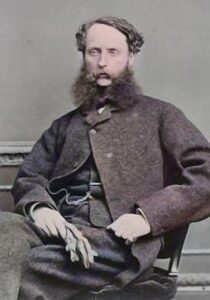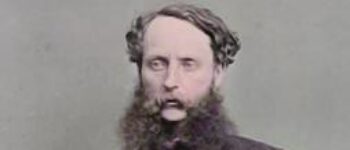1844: The Birth of Pastoralism
May 9, 2022
By AHNZ

Today in New Zealand history, 9 May, 1844, is as good a day as any to signal the birth of pastoralism in New Zealand. We had counting for a long time before we had mathematics, and we had sheep (c.1833) before there was pastoralism. Today marks the moment in our history when someone really got into it and that someone was Frederick Weld (image, left.)
Weld, along with Charles Bidwill, did the dirty work of mustering the sheep about the Wairarapa while his elder cousin, Charles Clifford, was the inspiration and the money man. The original How To Colonise script that Edward Gibbon Wakefield hatched was not for New Zealand to be a grass-based economy at all but one of farmers. Wakefied, an economic meglomaniac, sought to impose a particular class social structure by use of State price controls he called ‘Sufficient Price.’ It soon became clear that such intensive farming was a fantasy and what New Zealand needed was extensive farming. This led to the era of Great Estates that grew our country and were paid back in ‘thanks’ by being attacked for political gain by George Grey and the Liberals (“Estate Busting.”)
“When Canterbury was colonised in 1850 the idea was to build a province out of small mixed farms. On paper, a good idea. Upon arrival it turned out that pasturalism-by-sheep was the winning combo and administrator John Godley had to break some rules and think on his feet. Hardly any of our early squatters, apart from the Australians who skipped over to Canterbury with their flocks to flee drought, knew how to farm sheep. ” – 1843: Ovis Aries Canterbury, AHNZ
 Weld was fresh off the boat from England and now faced his life’s first outdoors experience along with the first New Zealand mass droving of sheep. After much adversity the flock was moved from the Hutt Valley out to the Wairarapa to land leased from Maoris. Government was making life tough for the Settlers and had been opposing their ventures all along, trying to farm the people the same way people would farm sheep. Governor Robert FitzRoy prevented Maoris from selling their land except through himself and probably thought he had all the options for escape covered. I think breaking out into the Wairarapa and leasing Maori land was considered Mission Impossible yet Weld and his determined Catholics did it anyway even though it involved manhandling every sheep individually over a river-crossing through the coastal surf.
Weld was fresh off the boat from England and now faced his life’s first outdoors experience along with the first New Zealand mass droving of sheep. After much adversity the flock was moved from the Hutt Valley out to the Wairarapa to land leased from Maoris. Government was making life tough for the Settlers and had been opposing their ventures all along, trying to farm the people the same way people would farm sheep. Governor Robert FitzRoy prevented Maoris from selling their land except through himself and probably thought he had all the options for escape covered. I think breaking out into the Wairarapa and leasing Maori land was considered Mission Impossible yet Weld and his determined Catholics did it anyway even though it involved manhandling every sheep individually over a river-crossing through the coastal surf.
Weld’s enterprise was up against it. New Zealand of this time did not have the government pests introduced later such as rabbits, stoats, weasels, ferrets, and possums. It did have native mosquitoes that tried to eat Fred alive. We also had feral pigs back then that were hardened and territorial by their contest with wild Maori dogs; The poor old Australian merino sheep had a hard welcome. The isolation, the foot-rot disease, and floods might not have been enough to beat Weld but ultimately his Maori landlords got it into their heads to crank up the rent. It’s worth wondering, did FitzRoy and his Ministers, who were dedicated to an Anglican New Zealand, get into the ear of those Maoris to thwart the Catholic syndicate?
In the end, Weld and Clifford followed the example of the Deans Brothers who became sick of Wellington’s restrictions and political hegemony. They bugged out for the South Island and took their sheep with them. So, the birth of pastoralism, as with everything innovative and new, was actively opposed by Government in the first place and then eagerly claimed by them and controlled as if they’d come up with it all along. It’s the same way for everything you can think of including radio, television, education, roading, and even our nation’s history itself.
Frederic Weld’s hard work paid off and he went on to be a Prime Minister of New Zealand until he health failed. He retired, in 1861, to his the estate home he built in North Canterbury, Brackenfield. Having a man around of such stature excited the locals very much and Weld helped draw people north to settle the vicinity of John Leith’s township, Leithfield. A celebrity was often used our early history to lead timid settlers into new ground and often it was inauthentic but not so with Weld and Brackenfield. At the front gate to his estate Weld brought religion to the area, building a Roman Catholic church that still exists today on a new site. Unfortunately the mighty Brackenfield was demolished in 1964¹ about 10 years before New Zealand caught the heritage bug but perhaps part of the reason why we did.
This might have been quite enough for Weld or anyone else. Recuperated at Brackenfield, Weld wrote a book about New Zealand and traveled back to Britain only to return again to the Southern Hemisphere with a second wind. He became Governor of Western Australia, of Tasmania, and Singapore. All of that must have seemed a very long way off on Weld’s 21st birthday (9 May 1844) when he was camping in the open with sheep and hugging them over rivers in the salt spray.
—
1 Ref. Landscape description, Alexander Turnbull Library
Image ref. Frederick Weld, Alexander Turnbull Library; Modified by AHNZ (2022)
 Like Comment Share
Like Comment Share





